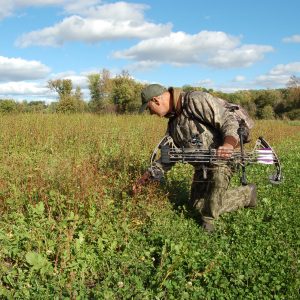What makes a state of affairs seem real to you? If you can see it, hear it, smell it, touch it – the more senses we satisfy, the more that scenario seems real. This is also true for whitetails? By using different techniques a hunter can appeal to a variety of the whitetails’ senses at once.
When using decoys it is important that you use the right decoy and accompanying stimuli to influence the specific deer you’re after to interact with your set-up scenario. These tips should help.
- Decoy posture. Some decoys sold are in an alert posture. This makes every deer in the area that sees your decoy become alert and edgy also. It depends upon the setting you’re trying to introduce, sometimes you may want an alert posture when submitting a competition or breeding scenario. However, for many settings you may want a feeding posture or even a bedded decoy to help portray a more relaxed situation.
- Movement. When is it natural for a standing deer to be totally motionless? – When it’s alert, when something is wrong or out of place, or just before it’s about to bolt? Many have tried a number of different things to add motion to decoys – from tying a string to a chicken feather or white hanky and taping the string to the hind end or ear of the decoy and letting the wind move it, to tacking a real whitetail-tail to the hind end of the decoy and operating it with monofilament line. Granted, in a fifteen MPH wind the chicken feather starts fluttering so fast it looks like the decoy will soon take flight, but even that extreme motion is better than no motion at all. There are kits available to help convert standard decoys into motion decoys and decoys that come with moving parts so hunters have options, but motion and posture are definite keys.
- Bad smells. You all know that a “whitetail lives by its nose.” It’s very important to keep your decoy clean. Some hunters store their decoy in the garage and wonder why whitetails snort and run away every time they get downwind of it. Wash your decoy in Scent Killer Soap and store it outside. When you touch it, always wear a pair of clean gloves. If you have to transport your decoy inside of a vehicle, put it in garbage bag or protect it in something that will keep odors from coming in contact with it.
- Good smells. When choosing lures and scents, again, think about what the specific deer you’re after wants at that specific time of the season. Think about “how” and “why” a buck might interact with your set-up. Right now is the perfect time to begin presenting a “breeding scenario” with some Special Golden Estrus. Often they will swing downwind to scent-check the set-up so using scent helps to conform that the situation is real. Make it seem as natural as possible and give them a reason to close the distance. When dispersing the scent, put the scent on a Pro-Wick or a Key-Wick near the decoy rather than pouring the smell right on the decoy. Simply because a week later your decoy smells like last week’s pee. This way you don’t have to constantly scrub down your decoy. Keep the decoy clean.






